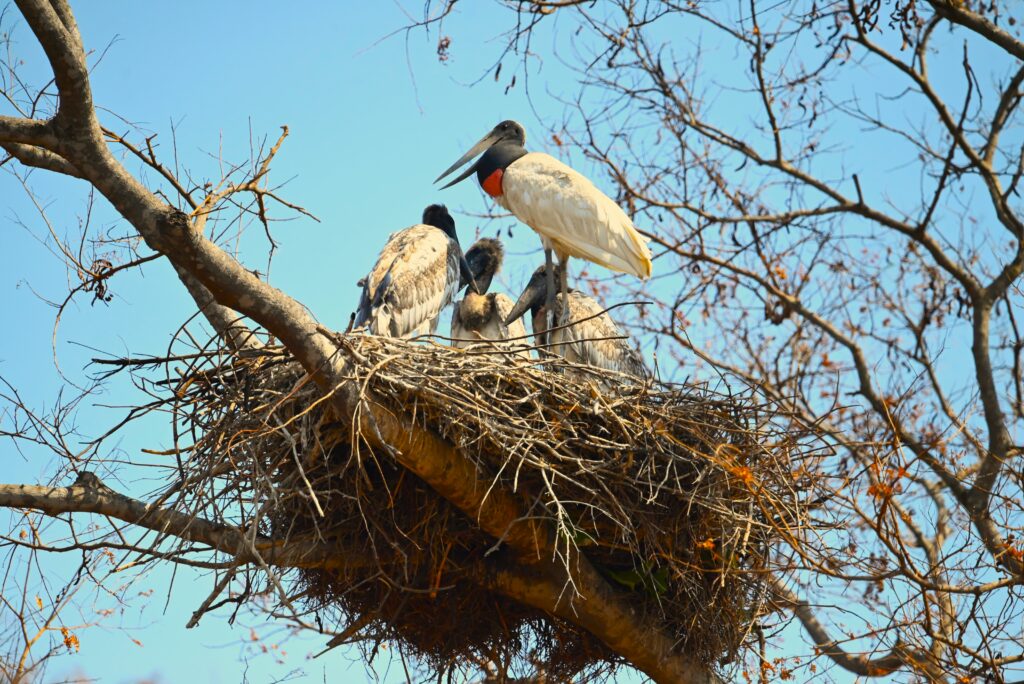
The majestic Jabiru Stork: A comprehensive Exploration.
Introduction:
The Jabiru stork, known scientifically as Jabiru mycteria, stands as a majestic symbol of grace and beauty in the avian world. This large stork, native to the Americas, has long captured the fascination of bird enthusiasts, researchers, and nature lovers alike. In this comprehensive article, we delve into the intricate details of the Jabiru stork, exploring its habitat, behavior, physical characteristics, conservation status, and its significance in the ecosystems it inhabits.
Taxonomy and Classification:
The Jabiru stork belongs to the family Ciconiidae, which includes other large wading birds like herons and ibises. Within this family, Jabiru mycteria is the sole representative of the genus Jabiru, making it a unique and distinct species.
Jabiru Stork physical Characteristics:
Standing tall with an impressive height of up to 5 feet and boasting a wingspan that can reach over 9 feet,. Undoubtedly, the Jabiru stork is one of the largest flying birds in the Americas. Moreover, its distinguishing features include a long, straight bill, a predominantly white plumage, and black primary and secondary feathers. The head and neck are often featherless and display a vibrant black or dark blue color, adding to the bird’s regal appearance.
Habitat and Distribution:
The Jabiru stork is predominantly found in wetland habitats, including marshes, floodplains, and swamps. Moreover, its distribution spans from the southern United States through Central America to northern Argentina. These storks are particularly associated with the vast wetlands of the Pantanal in Brazil, where they find an abundance of food and suitable breeding grounds.
Jabiru Stork behavior and Reproduction:
Certainly, known for their slow and deliberate movements, Jabiru storks are expert foragers. Basically, their diet primarily consists of fish, amphibians, reptiles, and even small mammals. During the breeding season, Jabirus gather in large colonies, constructing massive stick nests atop trees. These nests, sometimes reaching several feet in diameter, serve as a testament to the stork’s commitment to its offspring.
Breeding and Parental Care:
Basically, the breeding ritual of Jabiru storks involves elaborate displays of mutual courtship. Once a pair has bonded, they engage in joint nest-building activities. The female typically lays two to four eggs, and both parents take turns incubating them. After that, the chicks, born with a covering of white down, grow rapidly under the attentive care of their parents.
Conservation Status:
Despite their large size and impressive stature, Jabiru storks face threats to their survival. In truth, Habitat loss due to agricultural expansion and human development poses a significant challenge. Additionally, disturbance to nesting sites and pollution of wetlands further jeopardize the species. Conservation efforts, including the protection of key habitats and awareness campaigns, are crucial for ensuring the continued existence of these magnificent birds. Local tour operators organizes a Pantanal trip to the areas where the Jabirus storks live, Tourists can observe the majestic bird on a Pantanal safari in the farms of the region.
Jabiru Stork cultural significance:
The Jabiru stork holds cultural significance for many indigenous communities in the Americas. In some cultures, these birds are revered as symbols of fertility and good fortune. Their imposing presence and distinctive appearance make them subjects of folklore and legends, enriching the cultural tapestry of regions where they are found.
Threats and Conservation Efforts:
As human activities continue to encroach upon natural habitats, the Jabiru stork faces increasing threats. Climate change, pollution, and habitat destruction contribute to the decline of wetland ecosystems critical for their survival. Conservation initiatives, such as the establishment of protected areas and sustainable land-use practices, are essential for safeguarding these majestic birds and the ecosystems they inhabit.
Conclusion:
In conclusion, the Jabiru stork stands as a remarkable example of the beauty and complexity of avian life. Its impressive size, distinct appearance, and important role in wetland ecosystems make it a species worth studying and protecting. As we strive to balance human development with the preservation of biodiversity, understanding and appreciating creatures like the Jabiru stork becomes crucial for fostering a harmonious relationship between humanity and the natural world.


